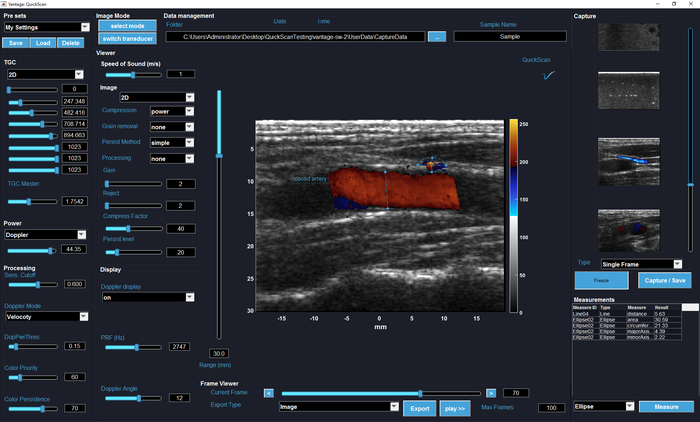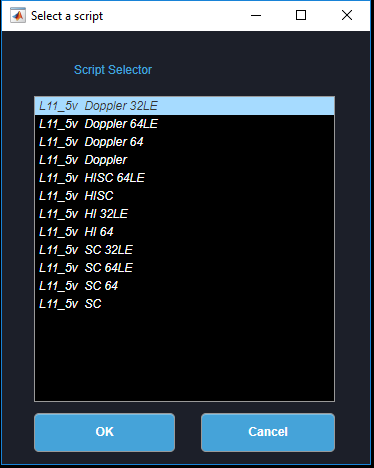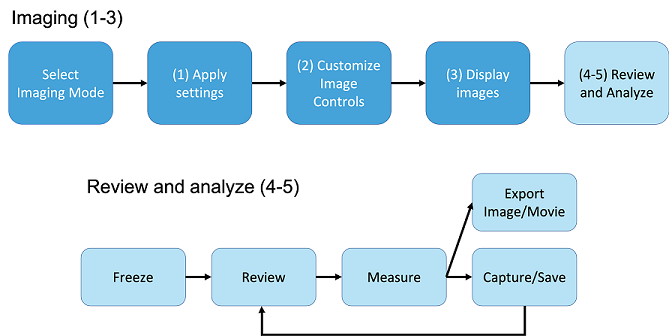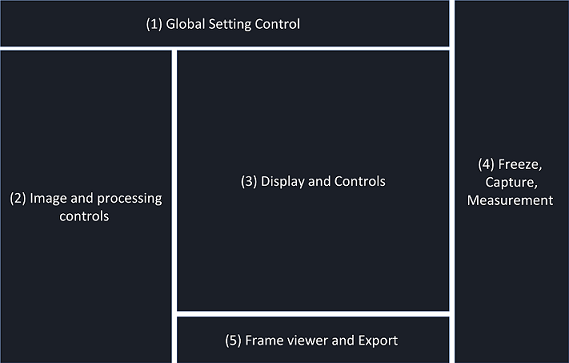Welcome to the fifth issue of Volume 4 of PLANE WAVE, Verasonics’ Newsletter through which we share information about new products and technologies, emerging applications, conferences, training opportunities, and collaborations with researchers in ultrasound and ultrasonic technologies. We hope you find these newsletters informative and interesting, and welcome your suggestions for future topics.
New Products and Applications Technology Information Research Conferences and Training
Introducing QuickScan: The Vantage™ Research Ultrasound System’s Easy-to-Use Software Designed to Improve the Researcher’s User Experience
The Vantage Research Ultrasound System is designed to provide engineers with unparalleled flexibility for leading-edge research in many ultrasound and related applications. Based on user feedback, we addressed a need for an easy-to-use Vantage user interface for situations that involve researchers who may not have an engineering background.
This article is written by Dr. Daniel Rohrbach, scientist and software engineer at Verasonics, describing his experience as a customer before he became an employee.
I recently recalled an experience before I started at Verasonics when I was trying to apply for an NIH grant to assess carpal-tunnel syndrome using quantitative ultrasound. The Vantage system, compared to other available research and clinical systems, was the perfect choice for the project. Not only would it allow me to implement the sophisticated ultrasound-processing procedures that are not available on any commercial clinical ultrasound system, but it would also let me integrate the features for real-time imaging using a graphical user interface.
We met with the team of physicians and sonographers performing the experiments and they demonstrated their approach to finding the right structures such as the median nerve, using the commercial devices that were available at the time. When we tried to repeat the experiments together using the Vantage system, we ran into some complications.
The Vantage system with its script-based research user interface is extremely flexible and thus, excellent for research purposes. With that, almost any ultrasound application theoretically can be implemented. However, for the clinical personnel, who did not have training in engineering related subjects, it was hard to use the software interface to operate the system. At that time I was still new to the Vantage system, but I was able to easily program some of the basic parameters and thanks to the many high-image-quality scripts and examples, I was able to produce adequate images, communicate with the clinical personnel, and we were able to submit the grant successfully.
After that experience, I thought, wouldn’t it be nice to have an optional software interface for the Vantage system that resembles a clinical system and reliably produces high-quality images? This would have made planning and communication with the clinicians so much easier.
Introducing QuickScan — A First of a New Generation of Software for Ultrasound Research
Verasonics is continually innovating the Vantage Research Ultrasound platform to meet customer needs, and we are proud to introduce QuickScan, a complementary software designed to provide a user-friendly, clinical-style graphical user interface (GUI) for real-time imaging. QuickScan will be available to all customers in the Vantage 4.3.0 software release.
QuickScan features a streamlined appearance with a dark color scheme and does not require users to have MATLAB® programming skills in order to operate the software. Figure 1 shows a screenshot of the QuickScan running a Doppler script.

Figure 1: Screenshot of the QuickScan interface.
The user is presented with a choice of different imaging modes that use Verasonics’ High-Image-Quality (HIQ) scripts. These can be switched dynamically during application runtime and include modes such as wide-beam spatial compounding, harmonic imaging, and wide-beam Doppler imaging. Figure 2 shows the script selector with a selection of all imaging modes that are available for the L11-5v transducer.

Figure 2: Script selector showing a selection of all imaging modes available for L11-5v transducer.
QuickScan is equipped with three distinct tools:
- A sophisticated, yet user-friendly data-capturing, review, storage, and export system
- A set of measurement tools including annotations
- A revised settings-storage tool
In addition to the common controls that are defined by the HIQ scripts, QuickScan provides a comprehensive set of imaging controls, which allow users to optimize B-mode as well as Doppler image settings for most common imaging scenarios.
Verasonics designed the QuickScan Software to promote a common and easy-to-use workflow (Figure 3) similar to clinical or preclinical ultrasound systems that support a retrospective capture and review process. The process can be roughly divided into 2 steps: (a) Imaging, and (b) data review, analysis, capture and storage.

Figure 3: Workflow of QuickScan imaging, as well as data analysis and review. Numbers correspond to the main panels of the interface organization (Figure 4).
QuickScan is organized into five main areas that represent the major features (Figure 4) and support the general workflow from left to right with the image display in the center.
- Global Setting Control
- Image and Processing Controls
- Display and Controls
- Freeze, Capture, Measurement
- Frame Viewer and Export

Figure 4: Overview of main Interface panels.
Intended Use
The QuickScan software is designed to provide an easy-to-use interface and thus, will simplify research in clinical and preclinical applications by easing communication with sonographers and physicians who may have limited engineering experience. When planning an interdisciplinary or clinical study with Vantage systems or discussing results, QuickScan could be used to acquire images, identify regions of interest, and help explain ultrasound images easier than with the Vantage system’s basic Research GUI.
QuickScan can be used for applications where researchers want to quickly image a region of interest with a set of highly optimized, preconfigured, and well-controlled settings, and thus eliminating the need to program a script and avoiding unexpected results due to programming errors when operated by an inexperienced user. Thus, QuickScan-captured, high-quality images can be used to identify regions (e.g., tissue types, organs, etc.) and to compare them to images and data that were acquired with research-based, customized, and specialized scripts.
Additionally, QuickScan offers a set of features that are currently not available with the Research GUI. These features include basic measurement calipers, cineloop capture controls, and data reviewing tools. This tool will be generally useful to present ultrasound studies in a more stream-lined and attractive interface.
Comparison to the Vantage Research GUI
Vantage system users are familiar with the current basic Research GUI (the standard GUI as defined in user-defined setup scripts), which provides an extremely flexible environment for use in highly specialized scripts and research applications. Although customizable, the correct functioning of the Research GUI greatly depends on accurate programming of the underlying setup script, which in many cases requires basic programming skills to operate correctly. This scripting approach allows the user to develop almost any ultrasound application that can be considered, and at the same time provides a basic graphical user interface to test the developed application. However, the basic research GUI may not be adequate or easy to use in all situations.
In order to provide a reliable tool that is less-affected by customer and research-related modifications of scripts or custom code, QuickScan was developed to be static without the capability to customize it at this time.
Future Perspectives
QuickScan is the first release of a series of software interfaces and tools for developing ultrasound applications. These applications and features will be released under Verasonics’ new software suite. Verasonics is excited to provide a new set of tools to our customers and is looking forward to introducing additional high-quality software to improve the overall experience of using the Vantage systems.
With your help, we hope to design even more applications in the future. Please do not hesitate to contact us with your questions and feedback.
Upcoming Webinar
Please join us for a live webinar at IEEE International Ultrasonics Symposium, “A New Generation of Graphical User Interface Software for the Vantage Platform: QuickScan and Improved Script-Based UI Controls.” More details coming soon.
During the COVID-19 crisis, we are here for you. Verasonics offers ultrasound simulator software that can assist in the continuation of research in a remote setting. Vantage customers have access to five simulator licenses with their system purchase that enable programming and verification of custom acquisition sequences without Vantage system hardware present. This allows for sharing of a single hardware system among multiple users and allows research and development teams to work virtually. To expand your lab’s efficiency while working remotely, Verasonics is offering increased access to the ultrasound simulator software to all customers. Verasonics is pleased to provide an additional five ultrasound simulator software licenses per account on a temporary basis (expires in 6 months). It is our sincere hope that we can support your goals and research during this unsettling time. For more information, please click here.
Visit Us and Learn What’s New at these Upcoming Conferences:
Currently there are no upcoming conferences, however, please join us for our next Vantage customer training via live webinar, 1-4 February, 2021, 9 – 11 am PT.
Please contact [email protected] to register or click here for more information.
Learn how to incorporate Verasonics’ Custom Image Reconstruction into your research projects, contact us.

